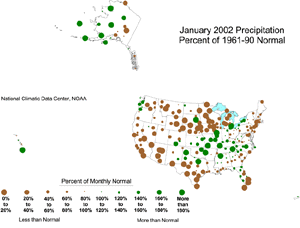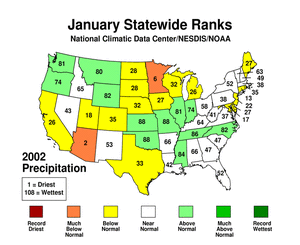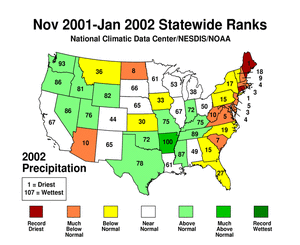National Overview
On the national scale,
|
 |
 |
Although some areas of the U.S. had well above normal precipitation, many areas were very dry. January averaged near normal when precipitation is integrated across the nation. Eleven of the last 30 months have averaged well below the normal, while only three averaged well above normal (see graph to right). National 2001-2002 precipitation ranks:
|
 |
Regional Overview
The beneficial rain and snow in the western U.S. during October through December abated slightly during January.
Short-term drought conditions were improved across much of the Pacific Northwest, however long-term deficits remained, especially east of the Cascades.
Drought continued its stranglehold across much of the Rockies, the eastern seaboard, and parts of the southern Plains.
Conditions deteriorated during January in the Southwest.
The northern Plains and western Great Lakes were dry during January, with two-month (December-January) deficits stretching from northern Minnesota to western Nebraska.
Parts of southeast interior Alaska had a dry January, while mountain snowpack across much of the state was below average. January rains in Hawaii helped alleviate dryness in the islands.
This overall pattern is evident in the following indicators:
Two other drought-related monitoring tools are the Vegetation Health Index and the Keetch-Byram Drought Index:
|
Western U.S. Drought
| January continued a run of wet months for the Pacific Northwest (see graph below right), however the moisture tap was reduced over much of the rest of the western U.S. The end-of-January mountain snowpack illustrated this regional pattern, with above-average snowpack in the Pacific Northwest and below-average snowpack across the rest of the Far West. The severe impact from last year's dry rainy season is reflected in early February 2002 reservoir levels that were generally still below seasonal norms. Highlights: |
|
 |
 This year's rainy season started out wet for the West region, but January came in as drier than normal (see graph above). Highlights:
|
 January 2002 marked the eighth consecutive month with near to well below-normal precipitation for the Southwest region (see graph above). Highlights:
The Colorado Drought Task Force met in January, expressing the following concerns:
|
 |
Wyoming had the 12th driest February-January, statewide, in 2001-2002. The recent drought, which started in March 2000, rapidly intensified to a peak in September 2001 which (based on the Palmer Hydrological Drought Index) rivaled the peak intensities of the 20th Century droughts in the state (see graph to left). |
January was dry across western and southern Texas, further exacerbating long-term drought conditions.
|
 |
Eastern U.S. Drought
| In January, there were areas of above-normal precipitation and below-normal precipitation in the east coast states. This resulted in regionwide January precipitation ranks of 33rd driest for the Northeast and 59th driest for the Southeast. However, severe long-term deficits remain. January was drier than normal for portions of the northern Plains and western Great Lakes (the East North Central region). |
 |
 |
|
January marked the fourth consecutive month with below to much below normal precipitation for the Northeast region, with October-January 2001-02 ranking as the second driest such period in the 108-year record (see graph to right). The dryness of the last three months was associated with unseasonably warm temperatures, with 2001-02 having the second warmest November-January on record.
Drought impacts have been noted in several states, with public water utilities in some communities requesting voluntary conservation and in others imposing mandatory water restrictions. Some highlights: |
 |
|
|
| Precipitation averaged across the Southeast region during January was near normal, but the dryness of the previous three months resulted in an October-January rank of sixth driest (see graph below left). Even though four of the last twelve months were wetter to much wetter than normal, the February-January rank was still only 29th driest. The drought epicenter in the Southeast continued to be South Carolina (see map below right), with the state having the driest August-January on record. |
 |
 |
| The East North Central region has had two consecutive months with precipitation averaging below normal (see graph to right), with January 2002 ranking as the 13th driest January in the 108-year record. The dryness was accompanied by unseasonable warmth, with 2001-2002 chalking up a record warm November-January. However, this is the winter dry season, so impacts have been minimal. |
 |

Additional Contacts:
| Damage due to the drought has been summarized by NOAA and the Office of Global Programs in the Climatological Impacts section of the Climate Information Project. Crop impact information can be found at the USDA NASS (National Agricultural Statistics Service) and Weekly Weather and Crop Bulletin pages. Drought statements by local National Weather Service Offices can be found at the NWS Hydrologic Information Center. Drought threat assessments and other information can be found at NOAA's Drought Information Center. Additional drought information can be found at the National Drought Mitigation Center, the USDA's National Agricultural Library, the interim National Drought Council, and the NOAA Paleoclimatology Program. The following states have set up web pages detailing current drought conditions and/or their plans to handle drought emergencies:
For additional information on current and past wildfire seasons please see the National Interagency Fire Center web site or the U.S. Forest Service Fire and Aviation web site. NCDC's Drought Recovery Page shows the precipitation required to end or ameliorate droughts and the probability of receiving the required precipitation. Additional climate monitoring graphics can be found at the Climate Prediction Center's monitoring pages: |
 NOAA's National Centers for Environmental Information
NOAA's National Centers for Environmental Information



